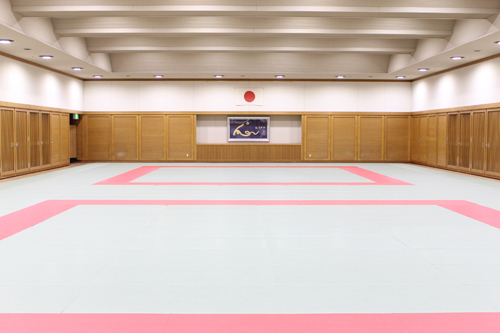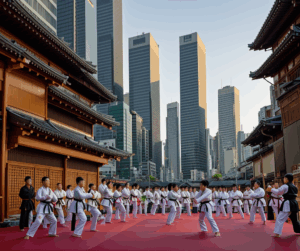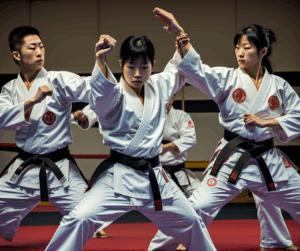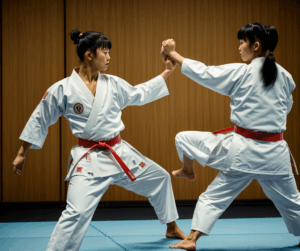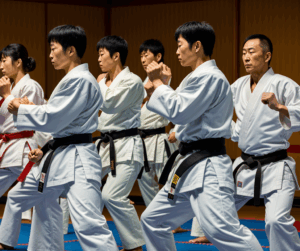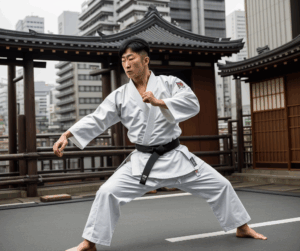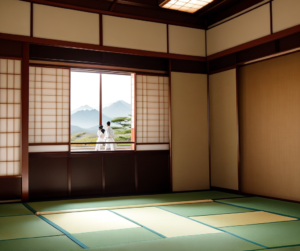Discover the Essence of Karate in Osaka
The History and Philosophy of Karate
Karate, originating from Okinawa, is a martial artsteeped in history and philosophy. Its roots can be traced back to indigenousfighting methods combined with Chinese kenpo. Over centuries, it evolved into adistinct discipline emphasizing self-defense, physical conditioning, and mentalfortitude. The word ‘Karate’ itself, meaning ’empty hand,’ reflects the art’sfocus on using the body as the primary weapon. The philosophy extends beyondmere combat; it promotes respect, discipline, and the pursuit ofself-improvement. Practitioners strive to cultivate a strong character,humility, and unwavering commitment to personal growth. Karate emphasizes notonly physical prowess but also the development of inner strength and moralcharacter. The dojo, or training hall, serves as a place for learning techniquesbut also for instilling values and fostering a sense of community amongstudents. These foundational principles shape the practice of Karate and guidestudents along their martial arts journey.
Benefits of Training: Mind, Body, and Spirit
Karate offers a multitude of benefits that extend far beyond physical fitness.Physically, Karate training enhances strength, flexibility, coordination, andcardiovascular health. The rigorous movements and demanding katas improve muscletone, endurance, and overall body awareness. Mentally, Karate promotes focus,concentration, and mental discipline. The need to memorize and execute complextechniques sharpens cognitive function and enhances problem-solving skills.Spiritually, Karate cultivates self-confidence, resilience, and inner peace. Thepractice instills a sense of accomplishment, encourages self-reflection, andpromotes a positive mindset. The discipline required to master Karate techniquestranslates into other aspects of life, fostering a sense of self-efficacy andempowerment. The benefits of Karate are comprehensive and holistic, positivelyimpacting the mind, body, and spirit of practitioners. It is a path to overallwell-being and personal growth.
Meet YourSensei: Koji Higa and the Dojo
At the heart ofany Karate journey is the Sensei, or instructor, who serves as a guide, mentor,and role model. Koji Higa, a 5th Dan Karate expert, embodies the qualities of adedicated and experienced Sensei. With years of training and teachingexperience, Koji Higa possesses a deep understanding of Karate techniques,philosophy, and pedagogy. The dojo, or training hall, provides a structured andsupportive environment for students of all levels to learn and grow. It is aplace where students can hone their skills, challenge their limits, and fostercamaraderie. The dojo emphasizes respect, discipline, and mutual support. KojiHiga creates a welcoming atmosphere where students feel comfortable learning andprogressing at their own pace. Through personalized instruction andencouragement, Koji Higa helps students unlock their potential and achieve theirKarate goals. He shares his knowledge and passion for Karate with unwaveringdedication, shaping not only skilled martial artists but also individuals ofstrong character.
Your First KarateExperience in Osaka
What to Expect in aTrial Lesson
Stepping into a Karate dojo forthe first time can be both exciting and nerve-wracking. A trial lesson isdesigned to provide a gentle introduction to the world of Karate, allowing youto experience the fundamental techniques and training methods. Expect to beginwith a warm-up session, including stretching and light exercises, to prepareyour body for the movements. You’ll then learn basic stances, punches, andblocks, focusing on proper form and technique. The instructor will guide youthrough each step, providing clear explanations and demonstrations. You’ll alsohave the opportunity to practice these techniques with a partner, fosteringinteraction and teamwork. The trial lesson will conclude with a cool-downsession to relax your muscles and prevent soreness. The goal is to provide a funand engaging experience that leaves you feeling energized and motivated to learnmore about Karate. It’s a chance to discover the basics and see if Karate is theright fit for you.
Essential Gear and Whatto Wear
When preparing for your first Karateclass, it’s important to wear comfortable and suitable attire that allows forunrestricted movement. Loose-fitting athletic clothing, such as a t-shirt andsweatpants or shorts, is generally recommended. Avoid wearing anything too tightor restrictive, as it may hinder your ability to perform the techniquesproperly. As you progress in your Karate journey, you’ll eventually need aKarate gi, or uniform. The gi is a traditional white outfit consisting of ajacket, pants, and belt. The belt signifies your rank and level of proficiencyin Karate. For your trial lesson, however, a gi is not necessary. In terms offootwear, Karate is typically practiced barefoot. This allows for better contactwith the ground and improves balance and stability. If you have any footconditions or prefer to wear shoes, consult with your instructor. They canprovide guidance on appropriate footwear options that won’t interfere with yourtraining. The main consideration is comfort and freedom of movement.
Class Etiquette and Dojo Culture
Entering a Karate dojo means entering a space steeped intradition and respect. Class etiquette is essential for creating a harmoniousand productive training environment. Bowing is a fundamental aspect of dojoculture, signifying respect for the instructor, fellow students, and the art ofKarate itself. Always bow when entering or leaving the dojo, and before andafter practicing with a partner. Listen attentively to the instructor’s guidanceand follow their instructions carefully. Avoid talking or disrupting the class,and maintain a respectful demeanor at all times. Keep your gi clean andwell-maintained, and address your instructor and senior students withappropriate titles, such as Sensei or Sempai. Cleanliness is also valued, ensureyou are clean before attending a class and that your uniform is clean. Byadhering to these customs, you contribute to a positive and supportive learningenvironment for everyone. Dojo culture emphasizes discipline, humility, andmutual respect, fostering a sense of community and camaraderie amongstudents.
Exploring Karate Styles in Osaka
Shotokan: The Power of Linear Techniques
Shotokan is one of the most widely practicedKarate styles in the world, characterized by its powerful, linear movements andemphasis on strong stances. Developed by Gichin Funakoshi, Shotokan focuses ongenerating maximum force through straight-line techniques, such as punches,kicks, and blocks. Stances in Shotokan are typically low and wide, providingstability and power. The style emphasizes kihon (basic techniques), kata(prearranged forms), and kumite (sparring). Katas in Shotokan are oftenperformed with dynamic movements and sharp transitions, showcasing the power andprecision of the style. Kumite emphasizes controlled sparring, allowing studentsto apply their techniques in a practical setting. Shotokan is known for itsrigorous training methods and its focus on developing both physical strength andmental discipline. The style emphasizes not only self-defense skills but alsothe cultivation of character and the pursuit of self-improvement. Shotokan is anexcellent choice for those seeking a powerful and effective martial art.
Goju-Ryu: Balancing Hardness and Softness
Goju-Ryu, meaning ‘hard-soft style,’ is a Karatestyle that harmonizes hard and soft techniques, emphasizing both power andfluidity. Developed by Chojun Miyagi, Goju-Ryu incorporates circular movements,breathing exercises, and close-range combat strategies. The style emphasizes theimportance of adapting to the opponent’s movements, using soft techniques todeflect attacks and hard techniques to counterattack. Sanchin kata, afoundational form in Goju-Ryu, focuses on developing internal strength andproper breathing. Breathing exercises, known as Ibuki, are integral to Goju-Ryutraining, helping to cultivate internal energy and enhance power. Close-rangecombat strategies, such as grappling and joint locks, are also emphasized inGoju-Ryu. The style is well-rounded and practical, suitable for bothself-defense and personal development. Goju-Ryu promotes balance, harmony, andadaptability, encouraging practitioners to cultivate both physical strength andmental resilience. It is a dynamic and effective martial art that emphasizes theinterconnectedness of mind, body, and spirit.
Other Styles and Dojo Options in Osaka
Osaka offers a diverse range of Karate styles and dojo options to choose from,catering to various interests and goals. In addition to Shotokan and Goju-Ryu,other styles such as Wado-Ryu, Shito-Ryu, and Kyokushin are also practiced inOsaka. Wado-Ryu emphasizes natural body movements and flowing techniques, whileShito-Ryu incorporates a wide variety of katas and techniques. Kyokushin isknown for its full-contact sparring and its emphasis on physical toughness. Whenchoosing a Karate style and dojo, consider factors such as teaching style, classschedule, dojo location, and the overall atmosphere of the dojo. Visit differentdojos and observe classes to get a feel for the training environment and theinstructor’s approach. Talk to current students and ask about their experiences.Choose a style and dojo that aligns with your interests, goals, and personality.The key is to find a supportive and inspiring environment where you can learn,grow, and achieve your full potential. Researching the different styles isimportant before making a decision.
Beyondthe Dojo: Karate in Daily Life
Self-DefenseSkills for Real-World Situations
Karatetraining equips you with practical self-defense skills that can be applied inreal-world situations. Beyond the techniques learned in the dojo, Karateinstills awareness, assertiveness, and the ability to assess threats. You’lllearn how to recognize potentially dangerous situations, avoid confrontationswhen possible, and protect yourself if necessary. Karate teaches you how to useyour body effectively as a weapon, utilizing techniques such as punches, kicks,blocks, and joint locks. You’ll also learn how to maintain a safe distance,control your emotions, and de-escalate conflicts. Self-defense is not just aboutphysical techniques; it’s about developing a proactive mindset and a sense ofpersonal safety. Karate empowers you to take control of your safety and protectyourself and your loved ones. The confidence and self-assurance gained throughKarate training can deter potential attackers and give you the courage torespond effectively in a dangerous situation. The art of Karate is verybeneficial when applied to the real world.
Building Confidence and Mental Resilience
Karate training fosters mental toughness, resilience, and self-assurance. Thechallenges faced in the dojo, such as mastering difficult techniques, pushingthrough physical limitations, and overcoming setbacks, build mental fortitudeand the ability to persevere in the face of adversity. As you progress in yourKarate journey, you’ll develop a sense of accomplishment and self-belief thattranslates into other areas of your life. You’ll learn to manage stress,overcome fear, and maintain a positive mindset. The discipline required tosucceed in Karate cultivates self-control and the ability to focus on goals.You’ll learn to set realistic goals, break them down into smaller steps, andwork consistently towards achieving them. Karate empowers you to overcomechallenges, manage stress, and maintain a positive outlook, fostering resilienceand self-confidence. The principles in Karate can set you up for success inlife.
Community and Camaraderie: The KarateFamily
Joining a Karate dojo means becomingpart of a supportive community of like-minded individuals who share a passionfor Karate. The dojo is more than just a training facility; it’s a place wherelasting friendships are forged, and a sense of belonging is cultivated. Studentstrain together, encourage each other, and celebrate each other’s successes.Senior students mentor junior students, sharing their knowledge and experience.The Sensei fosters a sense of unity and respect within the dojo, creating apositive and supportive environment for everyone. The camaraderie and supportwithin the Karate community can be invaluable, providing motivation,encouragement, and a sense of accountability. The friendships formed in the dojooften extend beyond the training hall, creating a network of support andcompanionship. The Karate family is a source of strength, inspiration, andbelonging, making the Karate journey even more rewarding and fulfilling. This isone of the most rewarding parts of Karate.
Conclusion: Your Karate Journey Starts Now!
Embrace the Challenge and Transform Your Life
Embarking on a Karate journey is an investment in yourself, offering thepotential for profound personal growth and transformation. Karate is not just amartial art; it’s a way of life that can enhance your physical, mental, andspiritual well-being. By embracing the challenge of learning Karate, you’llunlock your inner potential, develop self-discipline, and cultivate resilience.You’ll gain practical self-defense skills, build confidence, and forge lastingfriendships. Whether you’re seeking physical fitness, mental clarity, or a senseof community, Karate offers a path to achieving your goals and transforming yourlife. Take the first step today and discover the power of Karate. Contact alocal dojo, schedule a trial lesson, and begin your unforgettable Karateexperience. Unleash your inner warrior and embark on a journey of self-discoveryand empowerment. You will not regret starting your Karate journey.
この記事はAI-SEOにより執筆されました

